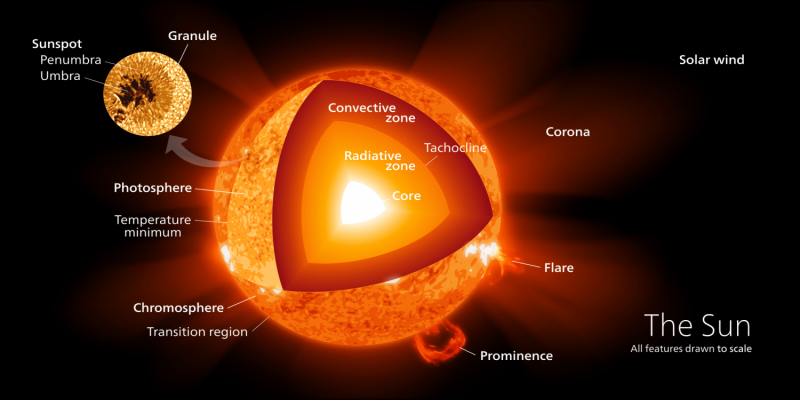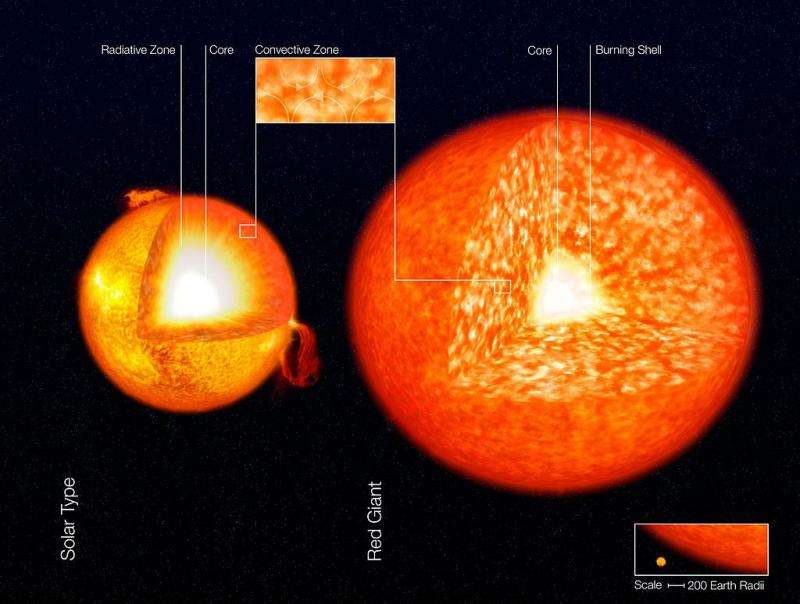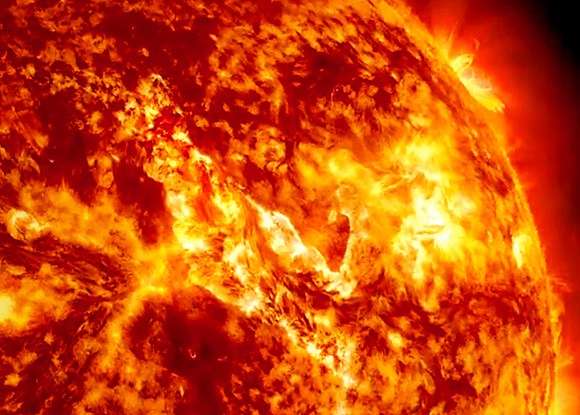No Matter How Dark It Gets the Sun Will Rise Again

There is a reason life that Globe is the only place in the solar organization where life is known to be able to live and thrive. Granted, scientists believe that there may exist microbial or even aquatic life forms living beneath the icy surfaces of Europa and Enceladus, or in the methane lakes on Titan. But for the time being, Earth remains the only place that we know of that has all the correct conditions for life to exist.
One of the reasons for this is because the Earth lies within our sun'southward Habitable Zone (aka. "Goldilocks Zone"). This means that information technology is in right spot (neither too close nor besides far) to receive the sun'south abundant energy, which includes the calorie-free and heat that is essential for chemical reactions. But how exactly does our sun get about producing this free energy? What steps are involved, and how does it get to usa here on planet Earth?
The simple answer is that the sun, like all stars, is able to create energy because it is substantially a massive fusion reaction. Scientists believe that this began when a huge cloud of gas and particles (i.due east. a nebula) complanate under the forcefulness of its own gravity – which is known as Nebula Theory. This not only created the big brawl of light at the eye of our solar organisation, information technology too triggered a process whereby hydrogen, collected in the heart, began fusing to create solar free energy.
Technically known as nuclear fusion, this process releases an incredible amount of free energy in the course of light and oestrus. Merely getting that energy from the heart of our sun all the way out to planet Earth and beyond involves a couple of crucial steps. In the end, it all comes downwards to the dominicus'southward layers, and the role each of them plays in making sure that solar energy gets to where it can help create and sustain life.
The Core:
The core of the sun is the region that extends from the centre to nearly 20–25% of the solar radius. It is hither, in the core, where energy is produced by hydrogen atoms (H) being converted into nuclei of helium (He). This is possible cheers to the extreme pressure level and temperature that exists within the cadre, which are estimated to be the equivalent of 250 billion atmospheres (25.33 trillion KPa) and fifteen.7 million kelvin, respectively.
The cyberspace result is the fusion of four protons (hydrogen nuclei) into one alpha particle – two protons and two neutrons spring together into a particle that is identical to a helium nucleus. Two positrons are released from this process, as well as two neutrinos (which changes 2 of the protons into neutrons), and energy.
The core is the simply function of the sun that produces an observable amount of heat through fusion. In fact, 99% of the free energy produced by the sun takes place within 24% of the sunday's radius. By 30% of the radius, fusion has stopped almost entirely. The residue of the sun is heated by the energy that is transferred from the core through the successive layers, eventually reaching the solar photosphere and escaping into space every bit sunlight or the kinetic free energy of particles.
The sun releases free energy at a mass–free energy conversion rate of four.26 million metric tons per second, which produces the equivalent of 384.six septillion watts (3.846×1026 W). To put that in perspective, this is the equivalent of about ix.192×10ten megatons of TNT per second, or 1,820,000,000 Tsar Bombas – the nigh powerful thermonuclear flop always built!
Radiative Zone:
This is the zone immediately adjacent to the core, which extends out to nigh 0.7 solar radii. In that location is no thermal convection in this layer, only solar material in this layer is hot and dense enough that thermal radiation is all that is needed to transfer the intense heat generated in the core outward. Basically, this involves ions of hydrogen and helium emitting photons that travel a short distance earlier being reabsorbed past other ions.
Temperatures drop in this layer, going from approximately seven million kelvin closer to the core to 2 million at the purlieus with the convective zone. Density also drops in this layer a hundredfold from 0.25 solar radii to the top of the radiative zone, going from xx g/cm3 closest to the core to just 0.2 g/cm3 at the upper boundary.
Convective Zone:
This is the sun's outer layer, which accounts for everything beyond 70% of the inner solar radius (or from the surface to approx. 200,000 km below). Here, the temperature is lower than in the radiative zone and heavier atoms are not fully ionized. As a result, radiative heat send is less effective, and the density of the plasma is low plenty to allow convective currents to develop.
Considering of this, rising thermal cells bear the majority of the heat outward to the lord's day's photosphere. Once these cells rise to simply below the photospheric surface, their material cools, causing their density increases. This forces them to sink to the base of operations of the convection zone once more – where they choice up more heat and the convective cycle continues.
At the surface of the sun, the temperature drops to about v,700 K. The turbulent convection of this layer of the lord's day is also what causes an consequence that produces magnetic north and due south poles all over the surface of the dominicus.

It is also on this layer that sunspots occur, which appear equally dark patches compared to the surrounding region. These spots stand for to concentrations in the magnetic flux field that inhibit convection and cause regions on the surface to drop in temperature to compared to the surrounding material.
Photosphere:
Lastly, there is the photosphere, the visible surface of the sun. Information technology is here that the sunlight and heat that are radiated and convected to the surface propagate out into infinite. Temperatures in the layer range between 4,500 and 6,000 Grand (four,230 – five,730 °C; 7646 – 10346 °F). Considering the upper part of the photosphere is cooler than the lower part, an image of the sun appears brighter in the center than on the border or limb of the solar disk, in a miracle known as limb darkening.
The photosphere is tens to hundreds of kilometers thick, and is also the region of the dominicus where information technology becomes opaque to visible light. The reasons for this is because of the decreasing amount of negatively charged Hydrogen ions (H–), which absorb visible light hands. Conversely, the visible lite we come across is produced every bit electrons react with hydrogen atoms to produce H– ions.

The energy emitted from the photosphere and so propagates through infinite and reaches Globe'south atmosphere and the other planets of the solar organisation. Here on Globe, the upper layer of the atmosphere (the ozone layer) filters much of the sun's ultra-violet (UV) radiation, but passes some onto the surface. The energy that received is then absorbed by the World'southward air and crust, heating our planet and providing organisms with a source of free energy.
The sun is at the center of biological and chemical processes here on Earth. Without information technology, the life cycle of plants and animals would end, the circadian rhythms of all terrestrial creatures would exist disrupted; and in time, all life on Earth would finish to exist. The sun's importance has been recognized since prehistoric times, with many cultures viewing it equally a deity (by and large, equally the main deity in their pantheons).
Just it is only in the past few centuries that the processes that power the sun accept come up to be understood. Cheers to ongoing research by physicists, astronomers and biologists, we are now able to grasp how the sun goes most producing free energy, and how it passes that on to our solar organisation. The written report of the known universe, with its diversity of star systems and exoplanets – has also helped usa to describe comparisons with other types of stars.
Commendation: How does the sun produce energy? (2015, December xiv) retrieved 18 March 2022 from https://phys.org/news/2015-12-sun-free energy.html
This document is subject to copyright. Apart from whatsoever fair dealing for the purpose of private study or inquiry, no part may be reproduced without the written permission. The content is provided for data purposes only.
Source: https://phys.org/news/2015-12-sun-energy.html
0 Response to "No Matter How Dark It Gets the Sun Will Rise Again"
Post a Comment